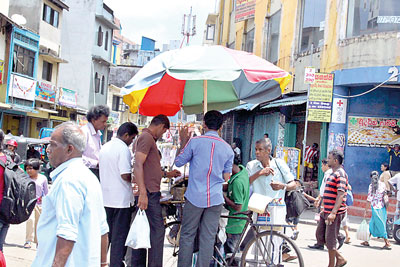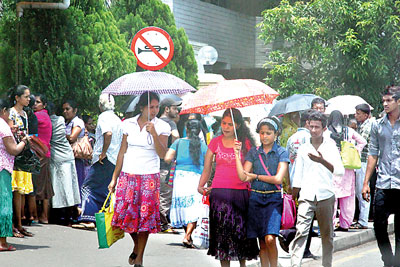By: Rumana Razick
As we go about our day to day activities atmospheric temperatures are increasing, ice caps are melting, sea levels are increasing, heat waves and heavy rainfalls are intensifying, fish and other creatures are migrating to the poles and in some cases going extinct.
Speaking to Daily Mirror the Chairman of the National Science Foundation in Sri Lanka Professor W.L. Sumathipala said in pre-industrial times the carbon dioxide concentration was 280 parts per million and at present due to industrialisation and forest clearance the carbon dioxide concentration has increased to 390 parts per million.
.jpg)
"Due to the prolonged drought during the last few months there has been a shortage in drinking water supplies in the north and north central province. At the moment demands are being met and there is no reason to panic"
“The carbon dioxide concentration will reach 450 parts per million in no time, increasing global temperatures by 2 degrees Celsius. The recent changes in temperature and rainfall in Sri Lanka tallies with the global change and these irregular weather patterns can be attributed to global warming. Sri Lanka is being affected by global warming and will gradually face the consequences,” he said.
Current Situation in Sri Lanka
Change in Weather Conditions - Director General Meteorological Department L.Chandrapala and S.R. Jayasekera
There has been an increase in the atmospheric temperature and rainfall intensity since the 1960s. Most models predict that there will be a decrease in

rainfall and shortage in water supplies in the long term. At present the night temperatures across the island have increased and the number of thunder days in Colombo has also increased. The intensity of cyclones in Sri Lanka is expected to increase with the increase in temperatures. In addition there is a slight decrease in the aerial annual rainfall volume and rainfall patterns have been irregular.
Depleting Water Resources- Director General Mahaweli Authority Gamini Rajakaruna
Due to a decrease in rainfall levels all reservoirs are depleting and the Anuradhapura and Polonnaruwa districts will be most affected. Due to the prolonged drought during the last few months there has been a shortage in drinking water supplies in the north and north central provinces. At the moment demands are being met and there is no reason to panic. However if the drought continues it will be difficult to meet the demands.
Power Generation – Spokesperson Ceylon Electricity Board Senajith Dassanayake
Water levels have fallen by 25% due to poor rainfall in the catchment areas and there is a water shortage in the dry zone. Due to this hydro based
_recast-DM_-10.jpg)
power generation has fallen from 40 percent to approximately 14 percent. To meet the electricity demand power generation has been switched to 86 percent thermal and 0.1 percent wind. Thermal power generation will be utilized to maximum capacity. However there would be an automatic trip to non priority feeders if there is an imbalance in power generation. If the drought persists and demands cannot be met the entire country will be affected. However at the moment there is no risk of an electricity crisis.
Crop Cultivation – Director General of Agriculture Department Rohan Wijekoon
We usually cultivate 2.7 million metric tonnes of paddy for the Maha season which is from October to February. However this season we were able to cultivate only 2.2 million metric tonnes. In the last five years there has been a 6 percent reduction in the land area to be cultivated and an 8 percent reduction in paddy production for the Maha season. This was due to the drought. With the slight increase in rainfall we are expecting 1.12 million metric tonnes of paddy production for the Yala season and that would be sufficient till December. If the drought continues in the worst possible situation we will be able to cultivate only 0.62 million metric tonnes of paddy. This would be sufficient till October. At present there is not enough water to cultivate to the maximum capacity and farmers have been asked to cultivate crops that require less water.
The Inter-governmental Panel on Climate Change (IPCC) which is a scientific intergovernmental body set up under the auspices of the United Nations to assess and understand the risk of human induced climate change published its report on climate change and the associated consequences. The report stated that global warming will have the greatest impact in South Asian countries.
According to experts the atmosphere is influenced by oceanic temperatures and ocean input. The atmosphere gets most of its energy from countries in the South Asian region. The South Asian region has a lot of islands that drives the changes in the atmosphere.
Professor Sumathipala explained the predictions made in the report, the effect these changes will have in Sri Lanka and the measures that need to be taken to address them.
Prediction
With the exponential increase in temperature sea levels will rise from 8cm to about 88cm by the end of the 21st century. Most of the countries that are tropical islands will submerge. Consequently by the end of the century low lying areas in Sri Lanka will submerge. As the sea level increases the salt water intrusion will ruin the fertile areas in the East ceasing cultivation.
The southern and western regions will be submerged destroying the urban and infrastructure development. The wet zone, that is the south west side will have more rain and the dry zone that is the central and north east regions will be drier which would cease cultivation in Anuradhapura and Polonarruwa regions. Salt water entering the river beds will move upstream and accumulate in the pumping stations. This will have its toll on the drinking water supply and result in a water shortage in the long term. Flash floods and landslides will increase and cultivable paddy fields will go under water.
Factors
Both global and local factors affect the changes in weather patterns. The El Nino effect which is the increase in temperatures in the East Pacific and decrease in temperatures in the West Pacific that decreases rainfall levels in South East Asian countries is occurring more frequently. As Sri Lanka is in the South East Asian border an El Nino with a great magnitude will result in low rainfall levels and drought in Sri Lanka. The burning of fossil fuels in Sri Lanka to generate power and the clearing of forests to make way for expressways and buildings also contribute to the increase in carbon dioxide concentrations.
Effects
Hydro power generation will cease due to water shortages and switching to thermal power generation will increase costs. Burning of finite fossil fuels will not only aggravates global warming but will also have a negative impact on the economy. Clearing trees and constructing highways will create a heat island resulting in a rise in temperatures. There will be sudden changes in the weather pattern due to changes made in the physical topography. Vector borne diseases like dengue and malaria will increase as the insect population increases due to irregular rainfall pattern. As global temperatures increase food production will decrease and with time there will be a food shortage.
 Measures
Measures
An alternative energy resources that is sustainable needs to be used. Renewable resources like solar, wind, tidal or bio mass should be used to generate electricity as oil is finite and would not last even 40 years. Incentives or tax concession should be given to the public to encourage them to use sustainable resources for day to day activities. Technology should be improved to predict weather patterns well in advance to make preparations with regards to cultivation and power generation. Urban developments that do not intervene with nature needs to be promoted. Proper planning and analysis on environmental and climatic impact needs to be done before infrastructure and urban development.
Research on different varieties of crops that is capable of adapting to change in weather patterns needs to be done.
.jpg)
.jpg)
 rainfall and shortage in water supplies in the long term. At present the night temperatures across the island have increased and the number of thunder days in Colombo has also increased. The intensity of cyclones in Sri Lanka is expected to increase with the increase in temperatures. In addition there is a slight decrease in the aerial annual rainfall volume and rainfall patterns have been irregular.
rainfall and shortage in water supplies in the long term. At present the night temperatures across the island have increased and the number of thunder days in Colombo has also increased. The intensity of cyclones in Sri Lanka is expected to increase with the increase in temperatures. In addition there is a slight decrease in the aerial annual rainfall volume and rainfall patterns have been irregular._recast-DM_-10.jpg) power generation has fallen from 40 percent to approximately 14 percent. To meet the electricity demand power generation has been switched to 86 percent thermal and 0.1 percent wind. Thermal power generation will be utilized to maximum capacity. However there would be an automatic trip to non priority feeders if there is an imbalance in power generation. If the drought persists and demands cannot be met the entire country will be affected. However at the moment there is no risk of an electricity crisis.
power generation has fallen from 40 percent to approximately 14 percent. To meet the electricity demand power generation has been switched to 86 percent thermal and 0.1 percent wind. Thermal power generation will be utilized to maximum capacity. However there would be an automatic trip to non priority feeders if there is an imbalance in power generation. If the drought persists and demands cannot be met the entire country will be affected. However at the moment there is no risk of an electricity crisis.
.jpg)